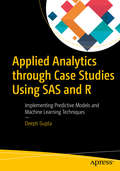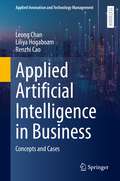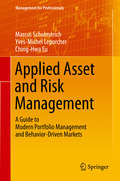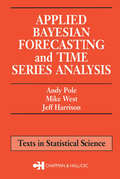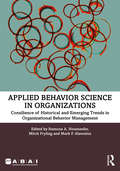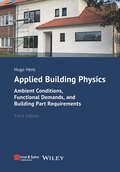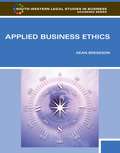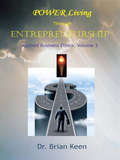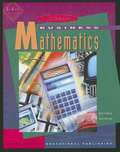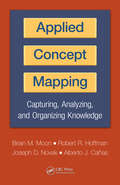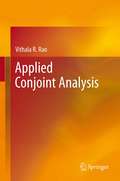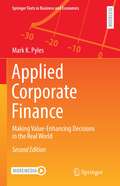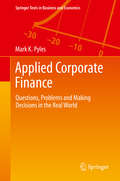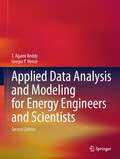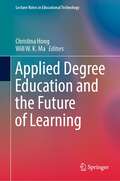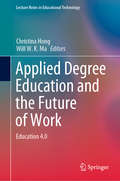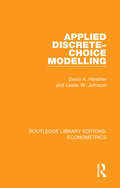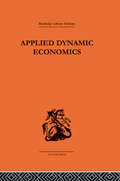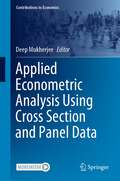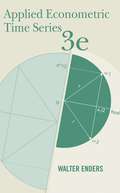- Table View
- List View
Applied Analytics through Case Studies Using SAS and R: Implementing Predictive Models and Machine Learning Techniques
by Deepti GuptaExamine business problems and use a practical analytical approach to solve them by implementing predictive models and machine learning techniques using SAS and the R analytical language. This book is ideal for those who are well-versed in writing code and have a basic understanding of statistics, but have limited experience in implementing predictive models and machine learning techniques for analyzing real world data. The most challenging part of solving industrial business problems is the practical and hands-on knowledge of building and deploying advanced predictive models and machine learning algorithms. Applied Analytics through Case Studies Using SAS and R is your answer to solving these business problems by sharpening your analytical skills. What You'll Learn Understand analytics and basic data concepts Use an analytical approach to solve Industrial business problems Build predictive model with machine learning techniquesCreate and apply analytical strategiesWho This Book Is ForData scientists, developers, statisticians, engineers, and research students with a great theoretical understanding of data and statistics who would like to enhance their skills by getting practical exposure in data modeling.
Applied Approaches to Societal Institutions and Economics: Essays in Honor of Moriki Hosoe (New Frontiers in Regional Science: Asian Perspectives #18)
by Tohru Naito Woohyung Lee Yasunori OuchidaThis book gives readers the theoretical and empirical methods to analyze applied economics. They are institutional economics, information economics, environmental economics, international economics, financial economics, industrial organization, public economics, law and economics, and spatial economics. Because the chapters of this book deal with current topics in these categories, they are relevant not only to researchers and graduate students but also to policy makers and entrepreneurs. As there is uncertainty about the global economy, it is necessary to consider optimal, efficient behavior to survive in the confused world. The book is organized in three parts. Part 1 deals with institutional economics, information economics, and related topics, approached through game theory. Part 2 focuses on environmental economics, international economics, and financial economics, through a microeconomic or econometric approach. Finally, Part 3 concentrates on public economics, social security, and related fields, through microeconomics or macroeconomics.
Applied Artificial Intelligence in Business: Concepts and Cases (Applied Innovation and Technology Management)
by Liliya Hogaboam Leong Chan Renzhi CaoThis book offers students an introduction to the concepts of big data and artificial intelligence (AI) and their applications in the business world. It answers questions such as what are the main concepts of artificial intelligence and big data? What applications for artificial intelligence and big data analytics are used in the business field? It offers application-oriented overviews and cases from different sectors and fields to help readers discover and gain useful insights. Each chapter features discussion questions and summaries. To assist professors in teaching, the book supplementary materials will include answers to questions, and presentation slides.
Applied Asset and Risk Management: A Guide to Modern Portfolio Management and Behavior-Driven Markets (Management for Professionals)
by Marcus Schulmerich Yves-Michel Leporcher Ching-Hwa EuThis book is a guide to asset and risk management from a practical point of view. It is centered around two questions triggered by the global events on the stock markets since the middle of the last decade: - Why do crashes happen when in theory they should not? - How do investors deal with such crises in terms of their risk measurement and management and as a consequence, what are the implications for the chosen investment strategies? The book presents and discusses two different approaches to finance and investing, i. e. , modern portfolio theory and behavioral finance, and provides an overview of stock market anomalies and historical crashes. It is intended to serve as a comprehensive introduction to asset and risk management for bachelor's and master's students in this field as well as for young professionals in the asset management industry. A key part of this book is the exercises to further demonstrate the concepts presented with examples and a step-by-step business case. An Excel file with the calculations and solutions for all 17 examples as well as all business case calculations can be downloaded at extras. springer. com.
Applied Bayesian Forecasting and Time Series Analysis
by Andy Pole Mike West Jeff HarrisonPractical in its approach, Applied Bayesian Forecasting and Time Series Analysis provides the theories, methods, and tools necessary for forecasting and the analysis of time series. The authors unify the concepts, model forms, and modeling requirements within the framework of the dynamic linear mode (DLM). They include a complete theoretical development of the DLM and illustrate each step with analysis of time series data. Using real data sets the authors: Explore diverse aspects of time series, including how to identify, structure, explain observed behavior, model structures and behaviors, and interpret analyses to make informed forecasts Illustrate concepts such as component decomposition, fundamental model forms including trends and cycles, and practical modeling requirements for routine change and unusual events Conduct all analyses in the BATS computer programs, furnishing online that program and the more than 50 data sets used in the text The result is a clear presentation of the Bayesian paradigm: quantified subjective judgements derived from selected models applied to time series observations. Accessible to undergraduates, this unique volume also offers complete guidelines valuable to researchers, practitioners, and advanced students in statistics, operations research, and engineering.
Applied Behavior Science in Organizations: Consilience of Historical and Emerging Trends in Organizational Behavior Management (Behavior Science)
by Ramona A. Houmanfar Mitch Fryling Mark P. AlavosiusApplied Behavior Science in Organizations provides a compelling overview of the history of Organizational Behavior Management (OBM) and the opportunity it presents for designing and managing positive work environments that can in turn have a positive impact on society. The book brings together leading experts from industry and research settings to provide an overview of the historical approaches in Organizational Behavior Management. It begins with an introduction to recognized practices in OBM and the applications of fundamental principles of behavior analysis to a variety of performance problems in organizational settings. The book then highlights how organizational practices and consumers’ behavior combine in a complex confluence to meet an organization’s goals and satisfy consumer appetites, whilst often unintentionally affecting the wellbeing of organizational members. It argues that the science of behavior has a responsibility to contribute to the safety, health and wellbeing of organizational members, consumers of organizational products, and beyond. Finally, the book recognizes the essential role of organizations in initiating, shaping, and sustaining the development of more nurturing and reinforcing work environments, through discussion of the need for innovation while adapting and responding to growing social upheaval, technological advances, and environmental concerns, alongside crises in the global economy, health, education, and environment. Showcasing emerging work by internationally recognized scholars on the application of behavior science in organizations, the book will be an essential read for all students and professionals of Organizational Behavior Management, as well as those interested in using organizational applications to create new models of management.
Applied Building Physics: Ambient Conditions, Functional Demands, and Building Part Requirements
by Hugo S. HensWhile the first volume on building physics deals with the physical principles of heat, air and moisture behaviour of buildings, building structures and components, this second volume on applied building physics focuses on the question of what the desired performance of buildings consists of. To achieve this, knowledge of the external environmental effects and the internal live loads to which buildings are subjected is a necessary first step. Subsequently, the performance requirements and the physical correspondences are deepened with the determination of their physical parameters, at the levels of buildings, building structures and building components. Compared to the second edition, the discussion of criteria is not limited to thermal comfort, but also includes acoustic, visual and olfactory aspects. Likewise, the indoor air quality is considered in a broader way. Analyses and calculations result in sustainable buildings with a comfortable indoor climate from functional and durable building constructions. Compared to the second edition, the text for the third edition has been reorganised, corrected, revised and expanded where appropriate. A useful appendix for quick reference contains standard values of material properties for a wide range of building materials. The analyses and calculations described in this book result in sustainable buildings made of functional and durable building constructions, with comfortable and healthy indoor climate and air quality. Compared to the second edition the text in this third edition has been reshuffled, corrected, reworked and extended where appropriate.
Applied Business Ethics
by Dean A. BredesonThe text applies practical ethical situations to real-world business settings and decisions. The text contains thought-provoking scenarios with up-to-the-minute issues that encourage active debate among peers.
Applied Business Ethics, Volume 2: POWER Living Through Entrepreneurship
by Dr Brian KeenThis is the second book in the Applied Business Ethics series. The first volume featured the Truth, while this volume features Entrepreneurship. The Theanthropic Ethical category is one of the few scientific ethical categories. Entrepreneurs will appreciate the fact that our work is evaluated by a fellow entrepreneur, who is an ethicist by profession. Entrepreneurs drive our business communities through resolving problems. This creates wealth for all stakeholders. All successful entrepreneurs establish enterprises that are based on ethical standards. For entrepreneurs the best ethical standards are based upon scientifically verifiable, objective standards. Theanthropic Ethics© is one of the few ethical categories that entrepreneurs can depend on. Through case studies of Canadian enterprises started by entrepreneurs, you will see how some enterprises have achieved success for centuries. All were initially successful because they implemented ethical standards. Theanthropic Ethics© is thoroughly evaluated within the context of entrepreneurship. You will see that freedom is an essential component for all entrepreneurs to become successful. Three Canadian enterprises are evaluated as case studies to show the benefits of being ethical.
Applied Business Mathematics
by Robert A. Schultheis Raymond M. KaczmarskiHelps students to assess what they've learned by providing excercises pertaining to what was learned in each chapter. Includes true/false, short answer, multiple choice, etc. questions.
Applied Business Mathematics (14th Edition)
by Robert A. Schultheis Raymond M. KaczmarskiThis classic, newly-revised book presents fundamental mathematics in the context of business and consumer applications to help put readers on the path to success. The all-new 1997 edition improves upon previous editions with a wealth of updated features. The material in Applied Business Mathematics will teach the student, the mathematical and critical thinking skills that will help him be a smart shopper, an informed citizen, and a valued employee.
Applied Cognitive Task Analysis in Aviation
by Thomas L. Seamster Richard E. ReddingDue to the requirements of automatic system design, and new needs for the training of complex tasks, Cognitive Task Analysis (CTA) has been used with increasing frequency in recent years by the airline industry and air traffic control community. Its power is reflected in the literature on professional training and systems design, where CTA is often cited as one of the most promising new technologies, especially for the complex cognitive tasks now confronting those working in aviation. The objective of this book is to bridge the gap between research and practice, to make what we know about CTA available to practitioners in the field. The book focuses on cognitive psychology and artificial intelligence analyses of aviation tasks. It is designed to help readers identify and solve specific design and training problems, in the flight deck, air traffic control and operations contexts. Distilling experience and guidelines from the best aviation cognitive analyses in accessible form, it is the first comprehensive volume on CTA, and is written for practitioners of cognitive analysis in aviation. It provides an overview of analyses to date; methods of data collection; and recommendations for designing and conducting CTA for use in instructional design, systems development, and evaluation. The first part of the book provides the principles and foundations of CTA, describing traditional approaches to task analysis and ways that cognitive analyses can be integrated with the analysis and development processes. The next part details how to: select the appropriate method or methods; determine job tasks that can be trained for automatic performance; extract knowledge structures; analyse mental models; and identify the decision-making and problem-solving strategies associated with experienced job performance. The authors also describe when to use and how to design and conduct a cognitive task analysis; how to use CTA along with traditional task analysis and ISD; and how to use CTA in training program development and systems design, as well as in personnel selection and evaluation. The current demand for cognitive analyses makes this a timely volume for those in aviation and, more generally, the industrial development and training communities. Readers will find this a thorough presentation of cognitive analyses in aviation and a highly usable guide in the design, implementation and interpretation of CTA. The book will be useful to instructional developers, aviation equipment and systems designers, researchers, government regulatory personnel, human resource managers, instructors, pilots, air traffic controllers, and operations staff.
Applied Concept Mapping: Capturing, Analyzing, and Organizing Knowledge
by Joseph D. Novak Robert R. Hoffman Brian M. Moon Alberto J. CañasThe expanding application of Concept Mapping includes its role in knowledge elicitation, institutional memory preservation, and ideation. With the advent of the CmapTools knowledge modeling software kit, Concept Mapping is being applied with increased frequency and success to address a variety of problems in the workplace.Supported by business appl
Applied Conic Finance
by Wim Schoutens Dilip MadanThis is a comprehensive introduction to the brand new theory of conic finance, also referred to as the two-price theory, which determines bid and ask prices in a consistent and fundamentally motivated manner. Whilst theories of one price classically eliminate all risk, the concept of acceptable risks is critical to the foundations of the two-price theory which sees risk elimination as typically unattainable in a modern financial economy. Practical examples and case studies provide the reader with a comprehensive introduction to the fundamentals of the theory, a variety of advanced quantitative models, and numerous real-world applications, including portfolio theory, option positioning, hedging, and trading contexts. This book offers a quantitative and practical approach for readers familiar with the basics of mathematical finance to allow them to boldly go where no quant has gone before.
Applied Conjoint Analysis
by Vithala R. RaoConjoint analysis is probably the most significant development in marketing research in the past few decades. It can be described as a set of techniques ideally suited to studying customers' decision-making processes and determining tradeoffs. Though this book is oriented towards methods and applications of conjoint analysis in marketing, conjoint methods are also applicable for other business and social sciences. After an introduction to the basic ideas of conjoint analysis the book describes the steps involved in designing a ratings-based conjoint study, it covers various methods for estimating partworth functions from preference ratings data, and dedicates a chapter on methods of design and analysis of conjoint-based choice experiments, where choice is measured directly. Chapter 5 describes several methods for handling a large number of attributes. Chapters 6 through 8 discuss the use of conjoint analysis for specific applications like product and service design or product line decisions, product positioning and market segmentation decisions, and pricing decisions. Chapter 9 collates miscellaneous applications of marketing mix including marketing resource allocation or store location decisions. Finally, Chapter 10 reviews more recent developments in experimental design and data analysis and presents an assessment of future developments.
Applied Conversation Analysis
by Charles AntakiMuch of everyday work is done through talk between practitioner and client. Conversation Analysis is the close inspection of people's use of language in interaction. The work reported in this collection shows how CA can be used to identify, and improve, communicative practices at work.
Applied Corporate Finance: Making Value-Enhancing Decisions in the Real World (Springer Texts in Business and Economics)
by Mark K. PylesThis textbook helps students truly understand how to apply the principles behind corporate finance in a real world context from both a firm and investor perspective. In its second edition, this text focuses on traditional theory applied to a holistic and realistic business case study, written as a novel set in current times so that all readers can relate. As such, this textbook offers readers both a quantitative and qualitative perspective on topics such as capital budgeting, time value of money, corporate risk, and capital structure. The sections are laid out to mirror the financial decision process, making it easier for readers to grasp the idea of the corporate financial life cycle. New topics such as socially responsible investing and private capital markets are also incorporated into this edition. Finally, PowerPoint slides, answer keys and data sets are available online for instructors.
Applied Corporate Finance: Questions, Problems and Making Decisions in the Real World (Springer Texts in Business and Economics)
by Mark K. PylesApplied Corporate Finance fills a gap in the existing resources available to students and professionals needing an academically rigorous, yet practically orientated, source of knowledge about corporate finance. Written by an expert in investment analysis, this textbook leads readers to truly understand the principles behind corporate finance in a real world context from both a firm and investor perspective. The focus of this text is on traditional theory applied to a holistic business case study, offering readers both a quantitative and qualitative perspective on such topics as capital budgeting, time value of money, corporate risk, and capital structure. Each section in the book corresponds to the order in which a business makes key financial decisions--as opposed to level of difficulty--allowing readers to grasp a comprehensive understanding of the corporate financial life cycle. Directly addressing the area of corporate finance in an applied setting, and featuring numerous case examples and end-of-chapter discussion questions and problems, this textbook will appeal to advanced undergraduates majoring in finance, graduate-level students, as well as professionals in need of a quick refresher on corporate financial policy.
Applied Data Analysis and Modeling for Energy Engineers and Scientists
by T. Agami Reddy Gregor P. HenzeNow in a thoroughly revised and expanded second edition, this classroom-tested text demonstrates and illustrates how to apply concepts and methods learned in disparate courses such as mathematical modeling, probability, statistics, experimental design, regression, optimization, parameter estimation, inverse modeling, risk analysis, decision-making, and sustainability assessment methods to energy processes and systems. It provides a formal structure that offers a broad and integrative perspective to enhance knowledge, skills, and confidence to work in applied data analysis and modeling problems. This new edition also reflects recent trends and advances in statistical modeling as applied to energy and building processes and systems. It includes numerous examples from recently published technical papers to nurture and stimulate a more research-focused mindset. How the traditional stochastic data modeling methods complement data analytic algorithmic approaches such as machine learning and data mining is also discussed. The important societal issue related to the sustainability of energy systems is presented, and a formal structure is proposed meant to classify the various assessment methods found in the literature. Applied Data Analysis and Modeling for Energy Engineers and Scientists is designed for senior-level undergraduate and graduate instruction in energy engineering and mathematical modeling, for continuing education professional courses, and as a self-study reference book for working professionals. In order for readers to have exposure and proficiency with performing hands-on analysis, the open-source Python and R programming languages have been adopted in the form of Jupyter notebooks and R markdown files, and numerous data sets and sample computer code reflective of real-world problems are available online.
Applied Degree Education and the Future of Learning (Lecture Notes in Educational Technology)
by Will W. K. Ma Christina HongThis book draws on the responses to learning and teaching and applied education futures thinking, that provide insights into the future of learning. It brings together more than 30 novel and important applied research and scholarly contributions from around the world, including Australia, Canada, Finland, Germany, Hong Kong, Japan, Macau, Mainland China, Malaysia, Morocco, Pakistan, and the UK. The chapters, including reflective essays and practice-based case examples, are divided into five major themes:• Future ready values and competencies for the future of work• Innovative pedagogies in applied degree learning and training• Driving student access, engagement, and success through digital technologies• Intelligent technologies: Embedding the new world of work into applied degrees• Lifelong learning, partnering, and the future of workThis book is important for readers interested in international perspectives on the future of work and professional education.
Applied Degree Education and the Future of Work: Education 4.0 (Lecture Notes in Educational Technology)
by Will W. K. Ma Christina HongThis edited volume sets the stage for discussion on Education 4.0, with a focus on applied degree education and the future of work. Education 4.0 refers to the shifts in the education sector in response to Industry 4.0 where digital transformation is impacting the ways in which the world of work and our everyday lives are becoming increasingly automated. In the applied degree sector, significant change and transformation is occurring as leaders, educators and partners evolve smart campus environments to include blended learning, artificial intelligence, data analytics, BYOD devices, process automation and engage in curriculum renewal for and with industries and professions. This volume aims to profile and enhance the contribution of applied educational practice and research particularly in the applied degree sector and includes contributions that show case real world outcomes with students and industry as partners. This edited volume includes a wide range of topics, such as rethinking the role of education and educators; curriculum and the future of work; industrial partnership, collaboration and work integrated learning; vocational and professional practices; students, industry and professions as partners; employability skills and qualities for the 21st century world of work; innovative pedagogy and instructional design; adaptive learning technologies; and data analytics, assessment and feedback. The contributors come from different parts of the world in higher education, including, Canada, China, Finland, Germany, Hong Kong, Italy, Macau, Singapore and the United Kingdom.
Applied Discrete-Choice Modelling (Routledge Library Editions: Econometrics)
by David A. Hensher Lester W. JohnsonOriginally published in 1981. Discrete-choice modelling is an area of econometrics where significant advances have been made at the research level. This book presents an overview of these advances, explaining the theory underlying the model, and explores its various applications. It shows how operational choice models can be used, and how they are particularly useful for a better understanding of consumer demand theory. It discusses particular problems connected with the model and its use, and reports on the authors’ own empirical research. This is a comprehensive survey of research developments in discrete choice modelling and its applications.
Applied Dynamic Economics (Routledge Library Editions)
by Kenneth K. KuriharaCollecting together papers from international journals, this book encompasses economics and the philosophical, historical, technical and practical facets of the real world. Grouped together in three separate, yet related parts, the essays deal with 'Problems of Developed Economies', 'Problems of Developing Economies' and 'International Prosperity and Progress'. Reviews of relevant books by Roy Harrod, T. Haavelmo, W. A. Lewis and T. Barna have been included as appendices. Truly international in its coverage and sources, this collection includes articles from the USA, Japan, the UK, India, Italy, Switzerland and Jamaica.
Applied Econometric Analysis Using Cross Section and Panel Data (Contributions to Economics)
by Deep MukherjeeThis book is a collection of 20 chapters on chosen topics from cross-section and panel data econometrics. It explores both theoretical and practical aspects of selected cutting-edge techniques which are gaining popularity among applied econometricians, while following the motto of “keeping things simple”. Each chapter gives a basic introduction to one such method, directs readers to supplementary references, and shows an application. The book takes into account that—A: The field of econometrics is evolving very fast and leading textbooks are trying to cover some of the recent developments in revised editions. This book offers basic introduction to state-of-the-art techniques and recent advances in econometric models with detailed applications from various developing and developed countries. B: An applied researcher or practitioner may prefer reference books with a simple introduction to an advanced econometric method or model with no theorems but with a longer discussion on empirical application. Thus, an applied econometrics textbook covering these cutting-edge methods is highly warranted; a void this book attempts to fills.The book does not aim at providing a comprehensive coverage of econometric methods. The 20 chapters in this book represent only a sample of the important topics in modern econometrics, with special focus on econometrics of cross-section and panel data, while also recognizing that it is not possible to accommodate all types of models and methods even in these two categories. The book is unique as authors have also provided the theoretical background (if any) and brief literature review behind the empirical applications. It is a must-have resource for students and practitioners of modern econometrics.
Applied Econometric Time Series (3rd edition)
by Walter EndersThis new edition reflects both sound structure and recent advances in time-series econometrics, such as out-of-sample forecasting techniques, nonlinear time-series models, Monte Carlo analysis, and bootstrapping.
